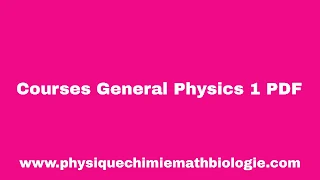Courses General Physics 1 PDF
General Physics 1 is a fundamental course that introduces students to the core principles of physics. This course lays the groundwork for understanding the physical world, covering essential topics such as mechanics, energy, and wave phenomena. It is crucial for students in various scientific and engineering disciplines.
Mechanics
Mechanics is the branch of physics that deals with the motion of objects and the forces that cause this motion. In General Physics 1, students explore several key concepts within mechanics:
1.Kinematics: This area focuses on describing motion without considering its causes. Key quantities include displacement, velocity, and acceleration. Students learn to analyze motion in one, two, and three dimensions using equations of motion.
2.Dynamics: Here, the causes of motion are examined. Newton's three laws of motion form the foundation of dynamics:
-First Law (Inertia): An object at rest remains at rest, and an object in motion continues in motion unless acted upon by a net external force.
-Second Law (F=ma): The acceleration of an object is proportional to the net force acting on it and inversely proportional to its mass.
-Third Law (Action-Reaction): For every action, there is an equal and opposite reaction.
3.Work and Energy: This section explores the concepts of work, kinetic energy, and potential energy. The work-energy theorem states that the work done on an object is equal to the change in its kinetic energy. The principle of conservation of energy, a cornerstone in physics, asserts that energy cannot be created or destroyed, only transformed from one form to another.
4.Momentum and Collisions: Students learn about linear momentum, impulse, and the conservation of momentum. Collisions are classified as elastic or inelastic, depending on whether kinetic energy is conserved.
5.Rotational Motion: This topic extends linear motion concepts to rotational systems. Key quantities include angular displacement, angular velocity, and angular acceleration. The parallel between linear and rotational dynamics is emphasized, with rotational analogs of Newton's laws.
Thermodynamics
Although primarily a focus in General Physics 2, introductory thermodynamics is often included in General Physics 1. This section covers basic concepts such as temperature, heat, and the laws of thermodynamics.
1.First Law of Thermodynamics: This law, also known as the conservation of energy, states that the change in internal energy of a system is equal to the heat added to the system minus the work done by the system.
2.Second Law of Thermodynamics: This law introduces the concept of entropy, stating that the total entropy of an isolated system can never decrease over time, leading to the concept of irreversibility in natural processes.
Waves and Oscillations
Wave phenomena are another crucial topic in General Physics 1. Students study the nature and properties of waves, including:
1.Simple Harmonic Motion (SHM): This type of oscillatory motion is characterized by a restoring force proportional to the displacement. Examples include pendulums and mass-spring systems.
2.Wave Properties: Key properties of waves include wavelength, frequency, amplitude, and speed. The relationship between these properties is explored through the wave equation.
3.Sound Waves: As a specific example of mechanical waves, sound waves are examined in terms of their production, propagation, and properties such as pitch and volume.
 |
| Courses General Physics 1 PDF |